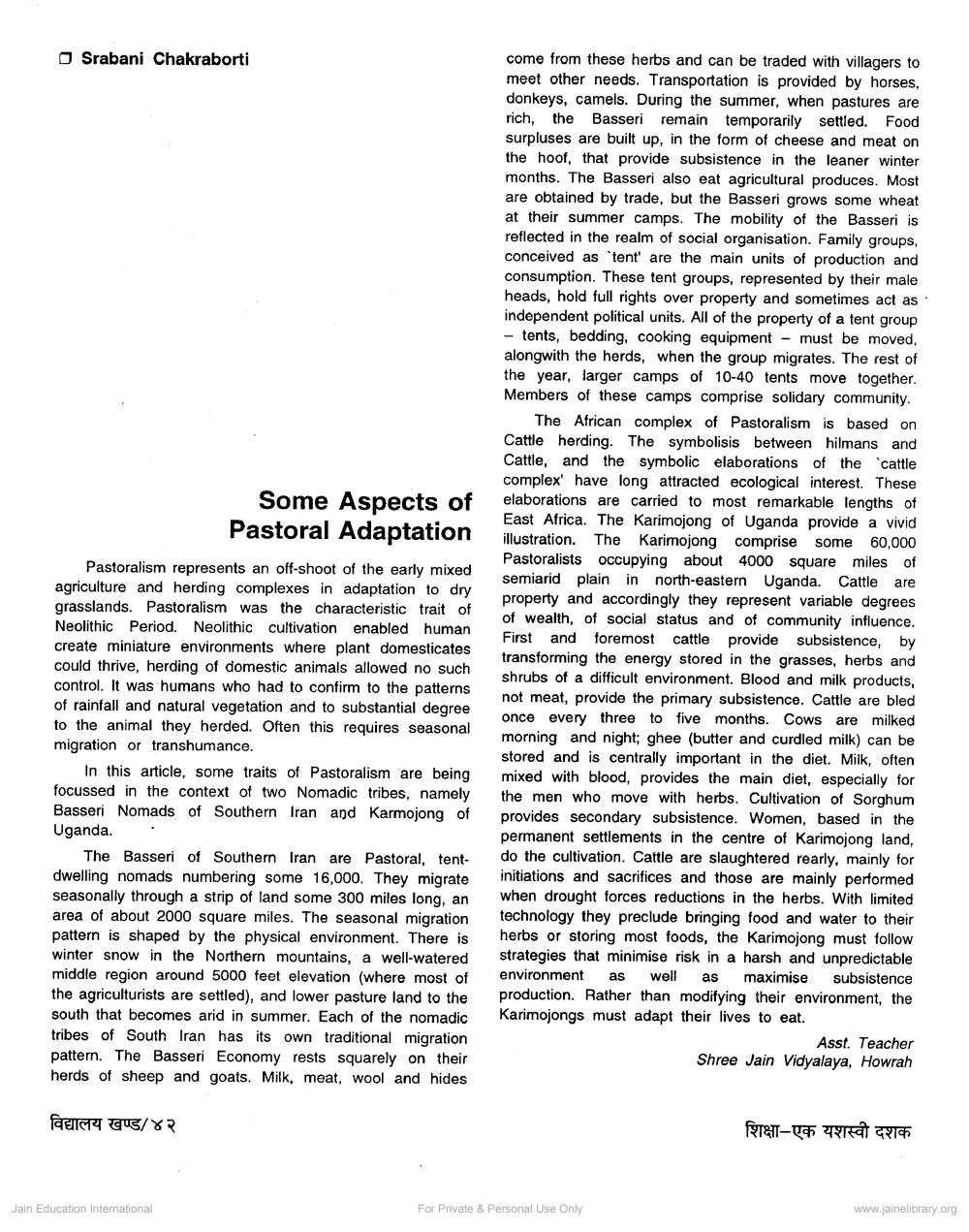________________
Srabani Chakraborti
Some Aspects of
Pastoral Adaptation Pastoralism represents an off-shoot of the early mixed agriculture and herding complexes in adaptation to dry grasslands. Pastoralism was the characteristic trait of Neolithic Period. Neolithic cultivation enabled human create miniature environments where plant domesticates could thrive, herding of domestic animals allowed no such control. It was humans who had to confirm to the patterns of rainfall and natural vegetation and to substantial degree to the animal they herded. Often this requires seasonal migration or transhumance.
In this article, some traits of Pastoralism are being focussed in the context of two Nomadic tribes, namely Basseri Nomads of Southern Iran and Karmojong of Uganda.
The Basseri of Southern Iran are Pastoral, tentdwelling nomads numbering some 16,000. They migrate seasonally through a strip of land some 300 miles long, an area of about 2000 square miles. The seasonal migration pattern is shaped by the physical environment. There is winter snow in the Northern mountains, a well-watered middle region around 5000 feet elevation (where most of the agriculturists are settled), and lower pasture land to the south that becomes arid in summer. Each of the nomadic tribes of South Iran has its own traditional migration pattern. The Basseri Economy rests squarely on their herds of sheep and goats. Milk, meat, wool and hides
come from these herbs and can be traded with villagers to meet other needs. Transportation is provided by horses, donkeys, camels. During the summer, when pastures are rich, the Basseri remain temporarily settled. Food surpluses are built up, in the form of cheese and meat on the hoof, that provide subsistence in the leaner winter months. The Basseri also eat agricultural produces. Most are obtained by trade, but the Basseri grows some wheat at their summer camps. The mobility of the Basseri is reflected in the realm of social organisation. Family groups, conceived as "tent' are the main units of production and consumption. These tent groups, represented by their male heads, hold full rights over property and sometimes act as independent political units. All of the property of a tent group - tents, bedding, cooking equipment - must be moved, alongwith the herds, when the group migrates. The rest of the year, farger camps of 10-40 tents move together. Members of these camps comprise solidary community.
The African complex of Pastoralism is based on Cattle herding. The symbolisis between hilmans and Cattle, and the symbolic elaborations of the 'cattle complex' have long attracted ecological interest. These elaborations are carried to most remarkable lengths of East Africa. The Karimojong of Uganda provide a vivid illustration. The Karimojong comprise some 60,000 Pastoralists occupying about 4000 square miles of semiarid plain in north-eastern Uganda. Cattle are property and accordingly they represent variable degrees of wealth, of social status and of community influence. First and foremost cattle provide subsistence, by transforming the energy stored in the grasses, herbs and shrubs of a difficult environment. Blood and milk products, not meat, provide the primary subsistence. Cattle are bled once every three to five months. Cows are milked morning and night; ghee (butter and curdled milk) can be stored and is centrally important in the diet. Milk, often mixed with blood, provides the main diet, especially for the men who move with herbs. Cultivation of Sorghum provides secondary subsistence. Women, based in the permanent settlements in the centre of Karimojong land, do the cultivation. Cattle are slaughtered rearly, mainly for initiations and sacrifices and those are mainly performed when drought forces reductions in the herbs. With limited technology they preclude bringing food and water to their herbs or storing most foods, the Karimojong must follow strategies that minimise risk in a harsh and unpredictable environment as well as maximise subsistence production. Rather than modifying their environment, the Karimojongs must adapt their lives to eat.
Asst. Teacher Shree Jain Vidyalaya, Howrah
विद्यालय खण्ड/४२
शिक्षा-एक यशस्वी दशक
For Private & Personal Use Only
Jain Education International
www.jainelibrary.org




